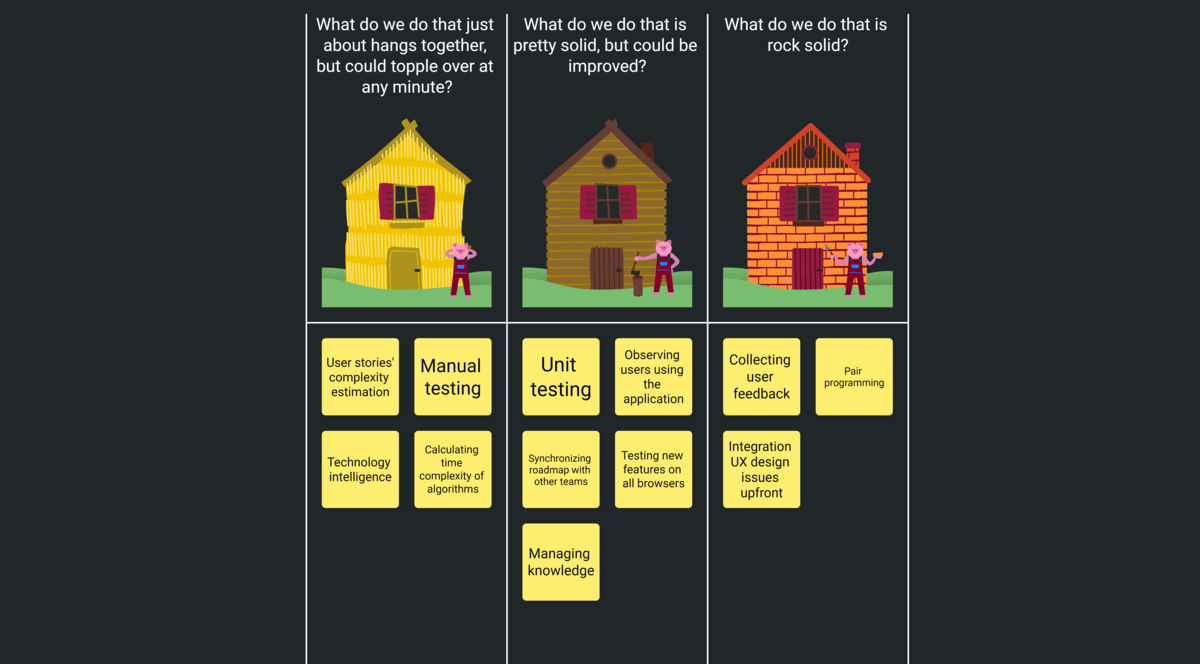What is the Three Little Pigs' Retrospective?
Inspired by the beloved Three Little Pigs nursery rhyme, the Three Little Pigs Retrospective is a fun and highly efficient workshop for assessing the progress made by an Agile team.
Everyone involved in the workshop is tasked with identifying and organizing the aspects of a project or a product under development into status categories that align to each of the pigs’ three “house” types. These categories are organized into separate columns on a whiteboard:
- House of straw: What is literally hanging together by a thread and could easily topple over at any minute? The goal here is to identify anything at risk of breaking. These are high-priority tasks or issues that require the team’s immediate attention.
- House of wood: What is already pretty solid but could still be improved upon? These issues still require attention but are at a lower priority than those high-priority tasks mentioned above.
- House of bricks: What have we done that is 100% rock solid? These tasks are the results that a team can be proud of and, thus, do not require further work or attention.
Remember, in addition to the pigs’ houses, there’s also the hungry wolf who’s trying to blow those houses down. Applying this same thinking to the Agile Framework, the wolf essentially represents all of the potential obstacles that could make the issues identified in the “House of Straw” and the “House of Sticks” more difficult to overcome.

5 steps for running a Three Little Pigs Retrospective
Generally speaking, this workshop involves four or five key steps—depending on your team’s prior experience with the Three Little Pigs' Retrospective methodology.
Step 0: If participants are new to this workshop method, the facilitator should provide a brief overview of what it entails: its various components, stages, and expected outcomes.
- As with any workshop method, there are a few best practices to uphold:
- Limit only one idea per sticky-note
- No limit around the number of sticky notes per column (aka, per “House”)
- No rules around what tasks or issues go into each column
Step 1: Set aside five minutes for participants to write down their answers on sticky notes and invite them to place those sticky-notes onto the three different columns.
Step 2: The facilitator then reads each sticky note aloud. If anything is unclear, the person who placed a vague or ambiguous sticky note on the board can explain his or her thinking. Once all sticky-notes have been read aloud and discussed, the facilitator should take a few minutes to “clean up” the whiteboard by grouping the sticky-notes around common themes or clarifying some of the language (if any of it was ambiguous in the first place).
Step 3: The facilitator then reads each sticky note aloud. If anything is unclear, the person who placed a vague or ambiguous sticky note on the board can explain his or her thinking. Once all sticky-notes have been read aloud and discussed, the facilitator should take a few minutes to “clean up” the whiteboard by grouping the sticky-notes around common themes or clarifying some of the language (if any of it was ambiguous in the first place).
Step 4: Now, it’s time to identify the three areas of improvement that the entire team will focus on in the near-term. To do this, participants are asked to “vote” for the ideas they feel are most relevant or essential for driving future success by placing colored dots on the three sticky-notes they feel are the highest priorities. The votes are then tabulated. The three areas of improvement having received the most votes will become the team’s new priorities. A single team member should be assigned to each area of improvement to ensure there’s always a single point-of-contact who can maintain accountability through task completion.
NOTE: If both ‘business value’ and ‘task complexity’ need to be considered during the evaluation process, feel free to use a prioritization matrix instead of the “dot voting” method.
Suggested resources to master the Three Little Pigs Retrospective
- A detailed article by Luis Parad on Medium: Retrospective Activity: The “Three Little Pigs”
- Another helpful article by Laura Hillman: Three Little Pigs
